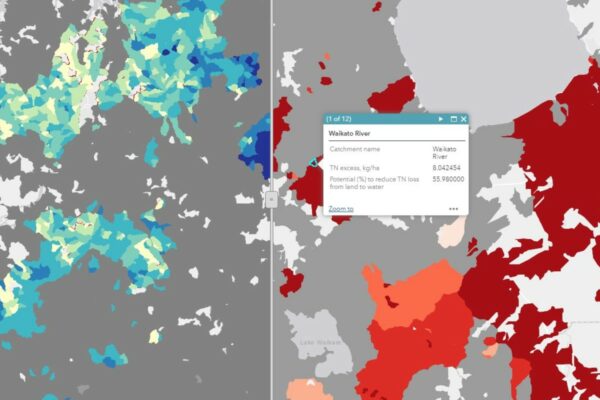Linking Legacies to Wai
Accounting for lag times and natural concentrations of contaminants in groundwater
Project Details Ngā taipitopito
Collaborators Ngā haumi
AgResearch | Aqualinc | DairyNZ | Environment Canterbury | Lincoln University | Ministry for the Environment
What are we doing?E aha ana mātou?
The decisions farmers make today on land can take many years to be reflected in the health of water in our rivers and groundwater. In the past, this ‘lag time’ contributed to a lack of understanding of the intrinsic connection between wai and whenua.
This research will demonstrate the effects of agriculture on our freshwater over the past 170 years and will predict how quickly future land-use decisions will restore the health of degraded water. The project aims to use this knowledge to grow understanding among land stewards of the connection between whenua and wai.
This project will have a focus on groundwater. It will find out how long it takes for changes in land use or intensity to be reflected in nitrate concentrations in groundwater.
How can the research be used? Ka pēhea e whai take ai te rangahau?
- The lag time between land-use changes (largely intensification) and the increase in the load of nitrate in streams and rivers has been quantified as 4.5 years on average for 77 catchments that capture about 50% of Aotearoa’s agricultural activity.
- A key finding of this research was that without human activity such as farming, nitrate concentrations in groundwater in Aotearoa would likely be around 1.65mg/L. This has given MfE and StatsNZ justifiable reference conditions for nitrate concentrations in groundwater, and advice that the appropriate national-scale threshold ought to be 1.65 mg/L. This finding is also important for considering a nitrogen bottom-line for rivers, because most baseflow in rivers is fed by groundwater.
- This research will help set realistic timeframes to decrease nitrate concentrations in groundwater, and streams and rivers. If nitrate is not decreasing quickly enough, Councils will have evidence to take further action.
Participation & engagement Te hunga i whai wāhi mai
- Māori, government (central and local) and peak industry bodies were asked to prioritise land uses, land practices and past and future years to be examined.
- DairyNZ’s environmental science team revisited dairy farms in five catchments to assess whether on-farm actions have helped improve water quality over time. The five catchments – Waiokura (South Taranaki), Toenepi (Waikato), Waikakahi (Canterbury), Bog Burn (Southland) and Inchbonnie (West Coast) – are dairy-dominated and were part of the 2001-2010 Best Practice Dairy Catchments project, which monitored water quality and environmental work on-farm.
 View Our Strategy Document 2019 – 2024
View Our Strategy Document 2019 – 2024











